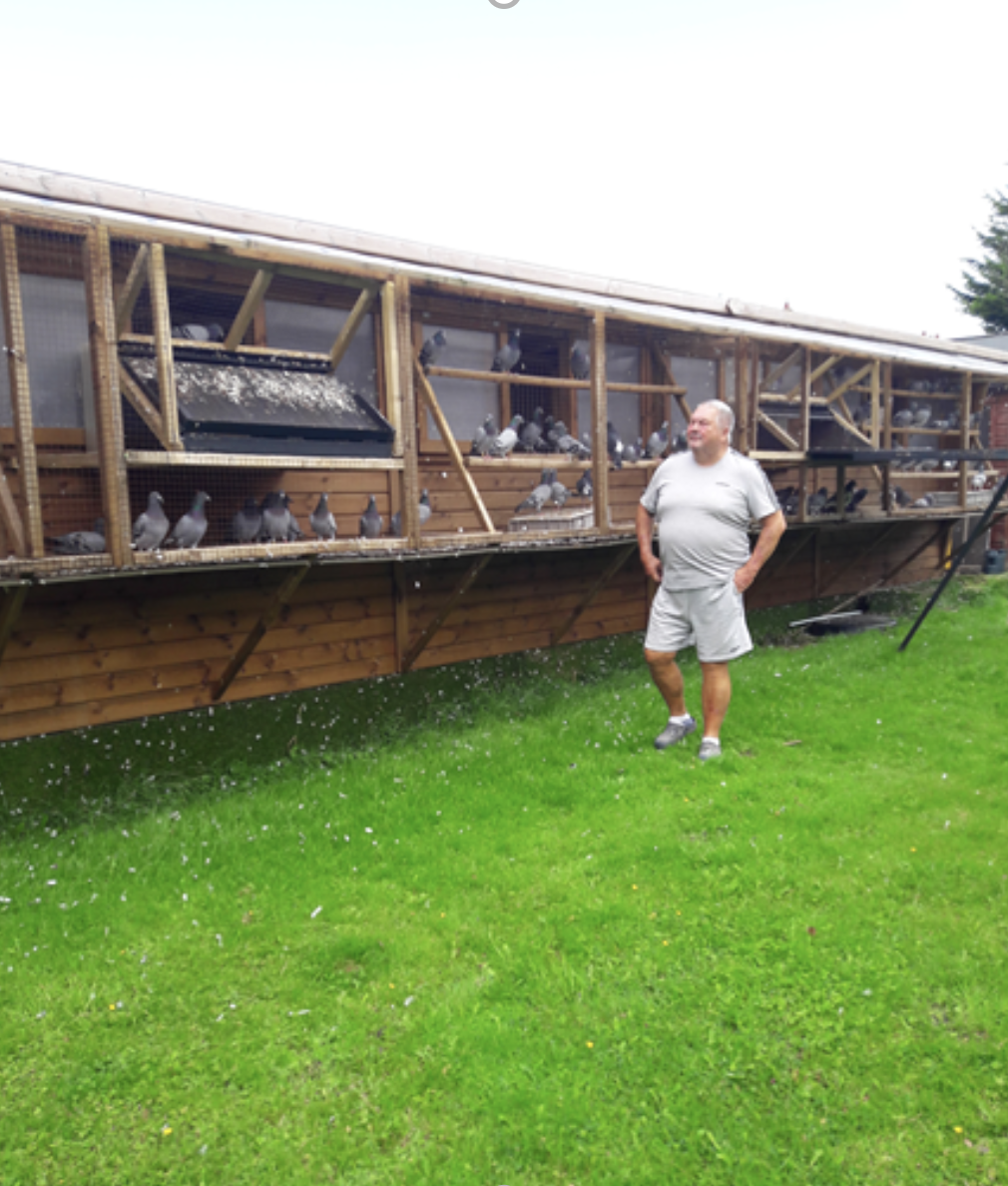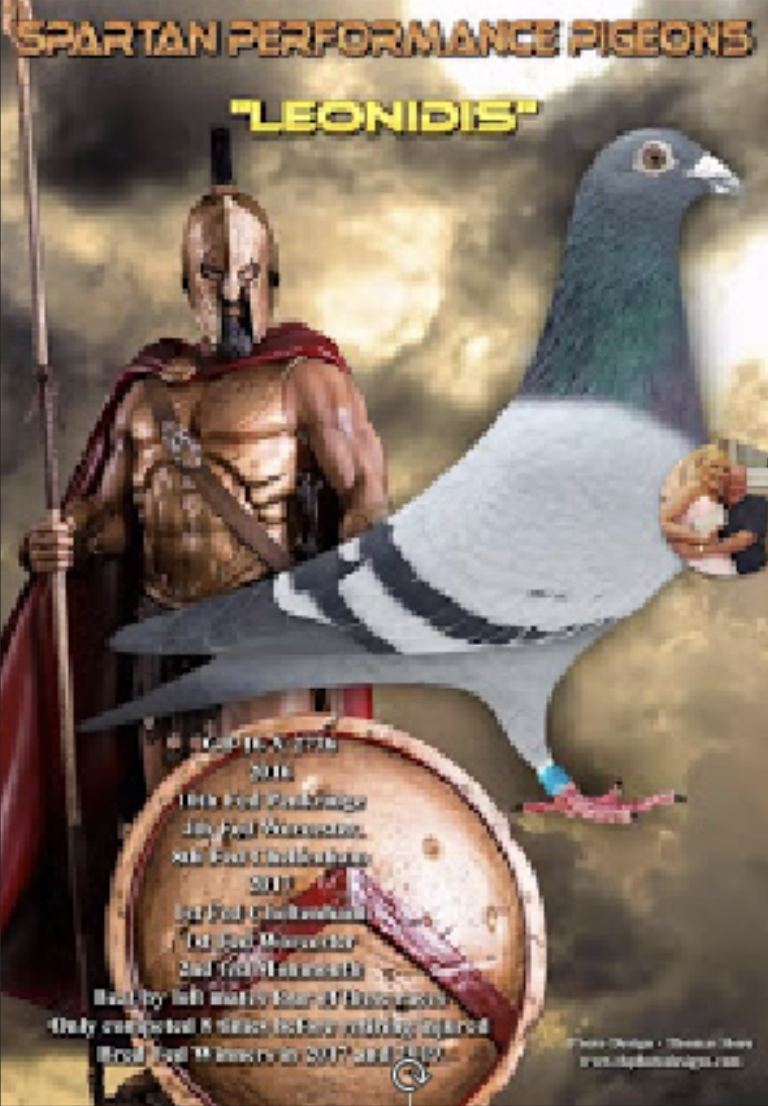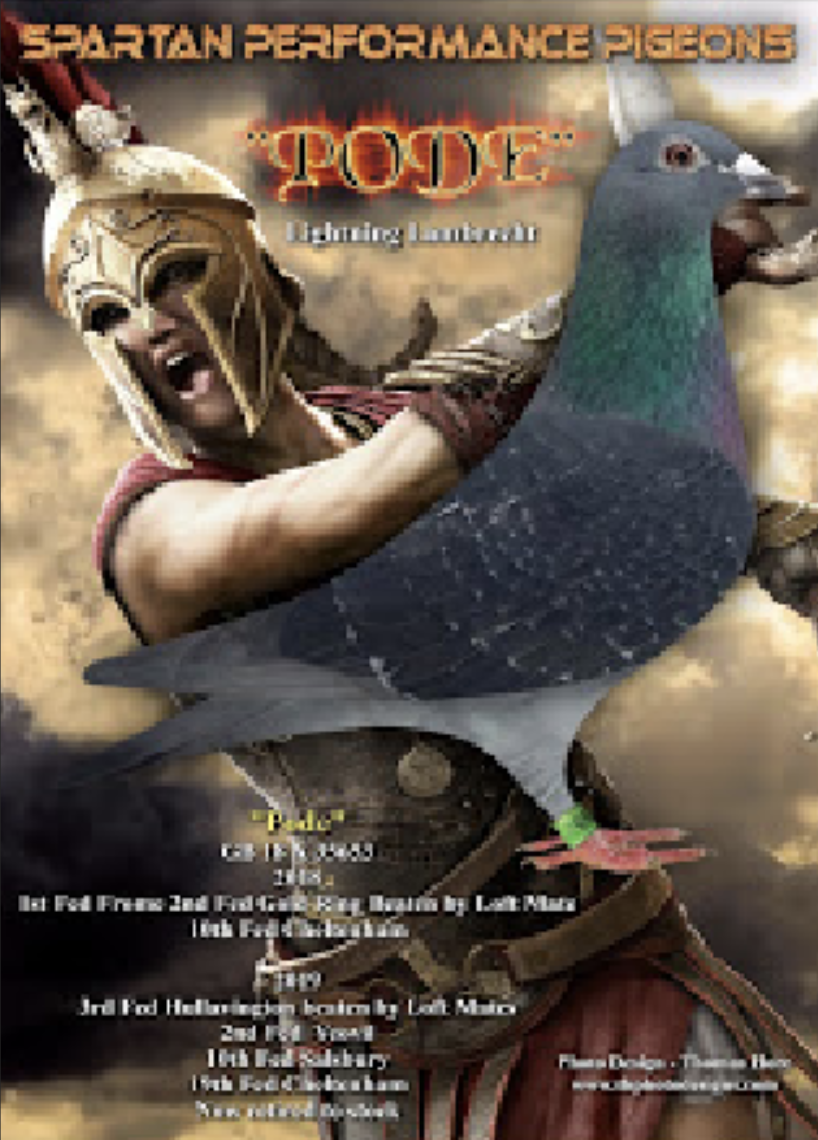Spartan Racing Pigeons – Origins
Spartan Racing Pigeons was created by two successful Pigeon Fanciers who were discussing the merits of high priced pigeons especially those from Europe and whether their contribution to a lofts success justified the high price. We reached the conclusion that a pedigree on its own rarely proved a guarantee for racing success and what was needed was a more pragmatic approach to breeding and racing pigeons, that would take into account the actual racing performance of the bird, its parents and/or grandparents.
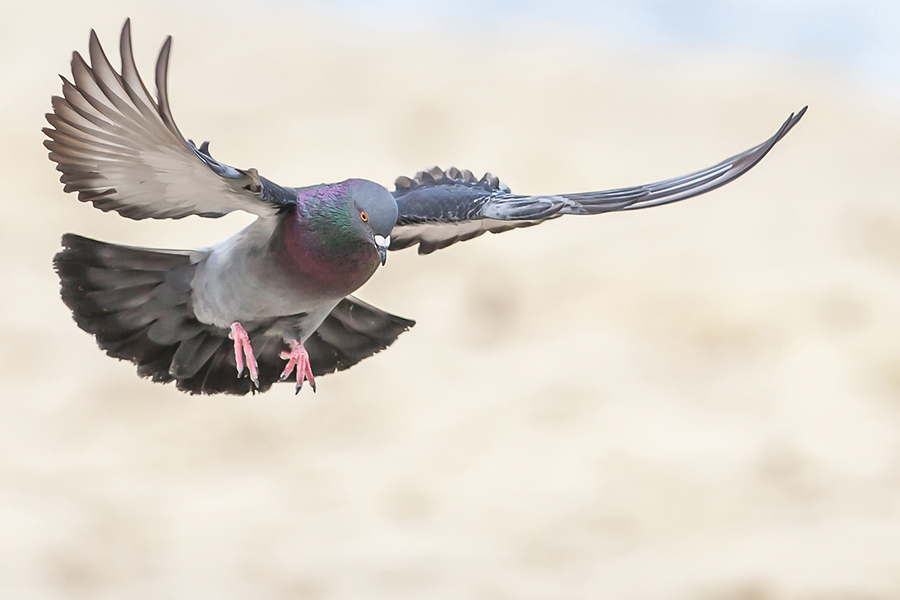
We also took into account the size of the loft and the performance of the family of pigeons rather than the exploits of one single pigeon i.e. we think you are more likely to have winner if it comes from a small/medium size loft (with no room for average pigeons) whose has numerous winning pigeons in their loft rather than say a large loft with one champion pigeon that accounts for the majority of the lofts wins. Another discussion is what accounts for a ‘meaningful win’ and as controversial as it may be we concluded a meaningful win was more than one win and it must be at Federation level and above. The other strand to the discussion was the price that should be paid we thought that auctions did not reflect the value of pigeon and often inflated prices can be paid if Foreign bidders became involved so to provide a level playing field we would value the pigeon at a fixed price depending upon its or its parents performance. i.e. we set out to provide ‘Pigeons with Performance’ at a fair price. The name ‘Spartan Racing Pigeons’ was adopted as the Spartans are universally accepted as one of the toughest and most dedicated warrior forces in ancient Greece who often defeated much larger forces.
The Spartans -The Few Defeat the Many
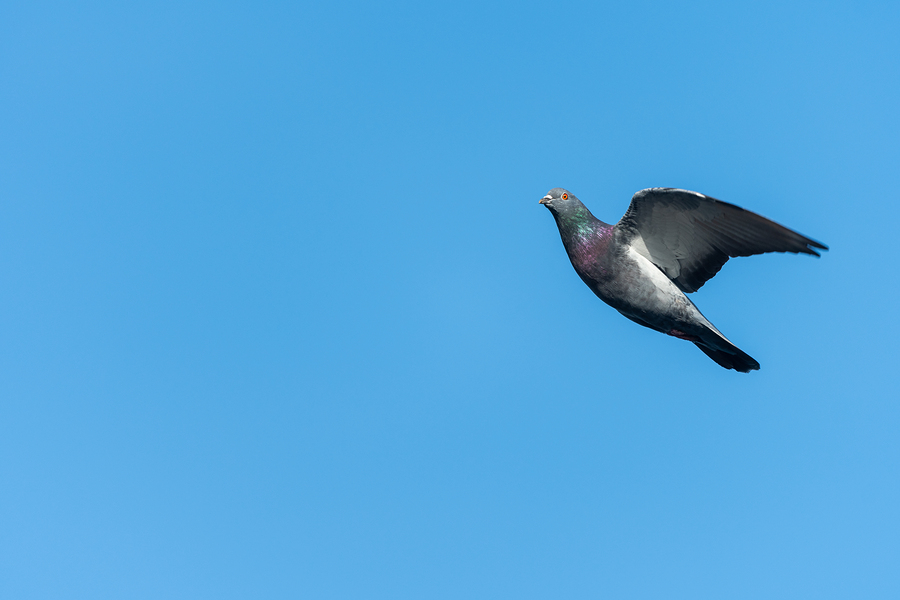
One of the most famous battles in history that defines the Spartans was the Battle of Thermopylas where the mighty Spartan King Leonidas with only 400 Spartans held off the impending Persian Army numbering many thousands. The eventual result having held the Persians at bay for many days was for the Spartans to lose the battle however Leonidas sacrifice served to unite the separate Greek interest and provide the time for them to organise and eventually defeat the invading Persian army. i.e. ‘Spartans allowed the Few to defeat the Many’ the analogy being we aspire for Spartan Pigeons to emulate i.e. small/medium size lofts can compete with any size of loft or field.
MORE ABOUT US
THIS IS AN ARTICLE FROM THE SQUILLS YEAR BOOK
INTRODUCTION
The purpose of this report is to try and capture the history and methods of a Fancier who has appeared at the Top of the Federation results for many years, the type of Fancier that we all admire but somehow are unable to easily emulate. The one thing I did find out from my visit is that John like several other top fanciers is the consummate dedicated ‘Professional’ leaving no stone unturned to ensure the wellbeing and success of his pigeons. This involves – getting up early, working within a strict and proven methodology, constantly observing the condition of his flock and working every spare moment to try and improve the chances of his race team.
THE BEGINNING
Q. When and how did you start with Racing Pigeons?
I first took an interest in pigeons as a boy in the early 60’s, when my mates and I used to catch ‘Scrags’ in the Red Shale football pitch, commonly known as the ‘Red Rec’ in Ardwick Manchester. The method used for capturing ‘Scrags’ was bread bait under a box propped up by a stick with a string attached. I remember spending hours waiting for a ‘coloured’ pigeon to take the bait. All captives were taken back to the old air raid shelter at the bottom of the yard and fed bread and water. Races were regularly held between friends where all birds were taken by bus or train in any direction and released – the winner was the first lad to be in the centre of ‘The Rec’ with their bird. We even clubbed together to buy a small trophy. At the age of 12, as I remember I was pretty hard to beat, as I had purchased a pair of ‘Mealies’ for £3 off a local fancier on the allotments. This ‘investment’ turned out to be a great deal as they won many of our ‘Rec Races’. Work, girls and motorbikes then came into my life and pigeons took a back seat for a number of years especially as I was following in my Dad’s footsteps and working away from home as a contract Painter and Decorator.
In 2008 I moved to the Blackpool Area with my other-half Sharon and a visit to the ‘Blackpool Show’ rekindled my interest. A farmer friend ‘Dave’ made an area in a small field available to erect a loft and I was at the beginning of a journey.
What Environment do you keep your Pigeons?
I have moved a few miles in the last year and have a loft in my own back garden that consists of 6 sections each 8ft -1 x Hens, 2 x Young Birds, 1 x Stock, 2 x widowhood Cocks. A corridor runs the entire length of the loft with two dividing doors. I have a Box Aviary running the length of the loft and have two Traps one for young birds and 1 for Old birds. In addition I have an 8ft shed in which I keep ‘Dads Army’ where I house my older stock birds.
What do you consider the essentials of a good loft and its maintenance?
I like the loft to be light, airy, dry and secure so that the birds can be content, relaxed and as free from illness as possible. I ensure my loft is not overcrowded and I clean the loft daily. I have aviaries so the birds can enjoy the sunshine as they wish. To keep the loft dry, free from bacteria and parasites I use Respro Sand Dry on the floors, I also put it on the perches and in the boxes and then brush it off onto the floor. This makes me feel good in that I feel I have done everything to protect the birds and my own health, as an added bonus it even smells pleasant in the loft.
Where did you source your pigeons?
The foundations of my pigeons are Leo Hermans and Cyril & Karl Lambrechts. They are mainly kept pure, but I have crossed winners with winners to ensure that I am able to compete from 60 miles to over 400 miles. If I am looking for an introduction then I would probably go to my friends Alan Curtis, Gary Wall, Ray Lunt or Jimmy and Gary Dutton. I have introduced pigeons from other top fanciers, but they must come from proven multiple winners that I think will help me develop a superior racing pigeon. All of these introductions I rigorously trial by racing with my own birds under my management system. In a nutshell they have to ‘race for their perch’ irrespective of pedigrees, conformation or cost.
What do you look for in a Pigeon?
I like my cocks and hens to be small to medium in size, have a ‘one flight tail’ and handle well. The type you pick up and do not want to put down. It does however come down to how they race, I like pedigrees with multiple winners on both sides of the family but I like winning more.
What Organisations do you belong?
I have been a member of the West Coast Federation since 2008
Lymm Federation since 2019
North West Grand National 2018
Bamford Gold Ring
Fylde 2 Bird
North West Combine
What Success have you enjoyed?
I have won over 40 x 1st Federations
1 x 1st Combine (of which I am very proud as it is only ever won in the Fylde area once in every 15 years or more)
I have had considerable success in the Gold Ring, Two Bird and Bamforth races.
My best season was in 2018 in which I won:
23 x 1st Club
9 x 1st Federation
1st and 2nd North West Grand National (Young Birds)
1st North West Combine – Messac -417 miles- (slowest race of the season and one of the longest flyers)
1st and 2nd Fylde 2 Bird Club
1st Section, 9th Open Bamford Gold Ring
2019
7 x 1st Federation
10 x 2nd Federation
1st Section, 10th Open Bamford Gold Ring
1st and 2nd North West Grand National
2020 – Having moved to my new location
To date with only 4 Young Bird races
Race One: Nantwich – 1st Club – 8th, 9th, 10th Federation
Race Two: Stafford – 1st, Club – 1st, 2nd, 3rd Federation
Race Three Hereford – 1st Club – 4th, 5th, 6th Federation
Race Four – Monmouth – 1st Club – 1st, 2nd, 3rd and 4th Federation
Race Five – Frome – 1st Club – 2nd Federation
NB: The above results are the main reason one just had to visit this Fancier as it looks like even a move of location is not going to affect John’s continued success.
Tell me about your Pigeons?
Stock Birds
My Leo Heremans and Lambrechts having moved to a new location mainly consist of ex-racers with big performances and pedigrees to match. They have provided many Federation and Specialist race winners for me and other fanciers throughout the UK including a 5th Open Midlands National Flying Club.
I house 16 pairs and they only stay in the loft if their offspring are winners. The ‘Dads Army’ contingent of birds is 8/9/10 years of age and still producing winning youngsters.
I introduce, breed and train my pigeons towards the goal of developing my own strain of pigeons that will win races between 60 and 400 miles
How do you manage your Old Birds?
I pair up my old birds at the end of January, they are allowed to raise 1 pair of young, with the hen being taken away when the young are about 15 days old, leaving the cock to complete the rearing.
The birds will be paired up again 3 weeks before the 1st race and the cocks trained to 20 miles as often as the weather permits.
The Hens are taken away the week before the first race after which no further road training is done and the birds are exercised around the loft twice daily.
The Hens are shown to the Cocks on the Friday prior to basketing and are in the nest box on return from a race.
The Hens are exercised at Home and are trained one week prior to their 1st race which is often 4 to 5 weeks into the season.
What do you feed your Old Birds?
When racing I feed them Gerry Plus and Bamfords Widowhood Mix. I have more Widowhood Mix at the beginning of the week and then gradually increase the Gerry Plus percentage through the week. I also add some seed at the end of the week nearer race day. I try and keep this as simple as possible and use a similar mix with my young birds when they are racing
How do you manage your Young Birds?
Young Birds are bred in January or early February and weaned at 21 days and put into a day pen to feed and drink. The Young birds are placed into the aviary but not encouraged to fly until the last young bird has joined the squad.
When the young birds are exercising well around the loft and ranging only then are they ‘road trained at 4, 8 and 12 miles, and are not moved on until they are clearing well from the release point and heading for home.
The young birds are then taken out to 20 miles where they are trained as often as time and weather permits until the 1st race.
After the first race the young bird road training continues if they are fresh and the weather is reasonable.
The Young Birds are fed the same as the widowhood racers.
How do you feed your Young Birds
When racing as mentioned previously they get a feed very similar to my widowhood cocks.
When they are weaned I give them a maize free, high protein mix until they are well into their training, then I start adding some Gerry Plus and Widowhood Mix as they mature
Do you have a Preventative Medicine Regime?
I treat with 4:1 Post Racing, Before Breeding and Pre-Racing
I vaccinate all birds to comply with DEFRA Regulations
I look for Canker and Respiratory Disease on a regular basis and treat accordingly
I always give Gerdon after medical treatments after tough races to ensure the pigeons’ gut flora return to normal
I often refer to Phil Gardner (RESPRO -SAND DRY) as he has a wealth of information on pigeon diseases and their treatment. He carries out extensive research into maximising the health and fitness of pigeons and is always extremely helpful and generous with his advice
Do you use any additives in the food or water?
I try and keep things simple and add some electrolytes to the water if the weather is especially warm and I add Gerdon to the water after a tough race or after administering medicines.
Do you have any views on the cause or cure for Young Bird Sickness?
I think it is mainly caused by stress and it is difficult to avoid even if you isolate your birds from other flocks. I try and keep a clean and airy loft with plenty of room and perch choices for the birds. I control my birds via their diet but the birds are well fed especially in the evening.
If the behaviour or droppings suggest a bird has young bird sickness I isolate and ‘starve’ the pigeon for twenty four hours before treating them by clearing their crop with a weak saline solution and keeping them on a light feed and ‘Gerdon’ in the drinker for one week.
Do you have any Favourite Pigeons?
I have to mention ‘The Salford Cock’ he was my first purchase in 2008 for the grand sum of £15 in a kit of young birds. This pigeon’s genes run through most of my loft as they consistently produce winners.
The second pigeon I always recollect is ‘Shaz’ who topped the North West Combine from Messac, 417 miles. She was put to stock in 2019 where she bred her first Federation winner (‘200 hen’) and has followed this up with her second Federation winner in 2020 (‘Sweet Sixteen’)
I have other multiple winners such as Leonidis, Pode, The Duckworth Cock, Augero and Ruby (1st NW Grand National) and the Bamford Bomber etc
Are there any Fanciers or Organisations in the Sport that you admire?
There are several great fanciers that come to mind but the three that will need no introductions to every fancier are the Curtis, Wall and Lunt partnership from Manchester. Alan, Gary and Ray’s results speak for themselves and might not ever be surpassed, winning 100’s of Club, Federation and Combine races. Their knowledge of the sport is second to none. They intensively research where the best birds may be found in the UK and Europe via each country’s fancy press and published results. They will jump on a plane or in a car to visit and talk to the next upcoming household name wherever he/she may be. They are very professional in their approach to purchasing, managing, training and feeding pigeons, they have a tried and vigorous system which they and their pigeons have to adhere to that has provided them with long term success. I have known them for many years and am proud to call them my good friends.
Do you have any tips for the treatment of your pigeons out of the racing season?
After racing, before breeding and before racing I treat with 4:1 Harkers.
I feed a good all round food mix out of the racing season.
What would you like to change in the Sport?
My idea for making the sport more competitive and interesting for Fanciers at all levels:
I would have a ‘3 Tier League System’ – There could be more or less tiers depending upon the number of competing members.
There would be Promotion and Relegation between Tiers/Leagues depending upon each year’s race results.
This would enable Fanciers to compete against fellow fanciers of similar ability irrespective of health, wealth or time.
I feel this would benefit the majority of the fancy who are becoming elderly and cannot get about and compete as fiercely or spend the funds or drive the car to train as often as when they were young. It would also encourage the novice.
This would give more fanciers something to look forward to on a Saturday night when the results are announced and there would be an overall league result to suit the elite flyers.
If you could live anywhere in the UK where would you choose to Race Pigeons?
I, like many fanciers in the North West think that although there are good fanciers throughout the UK, we would have more success in ‘The ‘Nationals’ if we lived on the East side of England, either in Norfolk, Suffolk, Kent. or in North Durham or for short races on the South Coasts. I however enjoy my racing here in the North West and expect that one day the conditions will suit fanciers in this area and then I will have my pigeons ready to take advantage of the opportunity.
What advice would you give to a novice fancier?
Decide what type of pigeon racing you wish to be involved with, do you want the ‘hard work and hands on’ experience of young bird racing or ‘old bird sprinting’ or the more relaxed approach of ‘distance racing’.
Obtain your pigeons from a trusted source who is regularly winning at Federation level racing at the distances you wish to compete.
Study the methods of successful fanciers especially the one from which you obtain your pigeons.
I would further suggest that one starts with a kit of youngsters and practice the husbandry and management by racing them. At the end of the first season one will have a better idea of how to manage pigeons and prepare for the Old Bird racing and breeding etc. The most important thing is to have fun and enjoy your pigeons.
What is your favourite moment in the sport?
Winning 1st and 2nd in the North West Nationals
What are your ambitions for the Future?
To win several more Nationals with my own family of pigeons
CONCLUSIONS
John Hassall is a dedicated 24 x 7 Fancier who leaves nothing to chance to bring his pigeons to peak fitness and motivation to win races. He trains his pigeons hard and without favour to select only the best. His ambition to produce his own family of ‘Spartan’ pigeons which will win from 60 to 400 miles in any weather I think has already been achieved. Sourcing his Leo Heremans and Lambrecht pigeons from proven top fanciers, prudently introducing new pigeons and testing them in the cauldron of racing before breeding winners with winners has given him the tools to achieve his second ambition and win another National.
Yours in sport
Squeaker
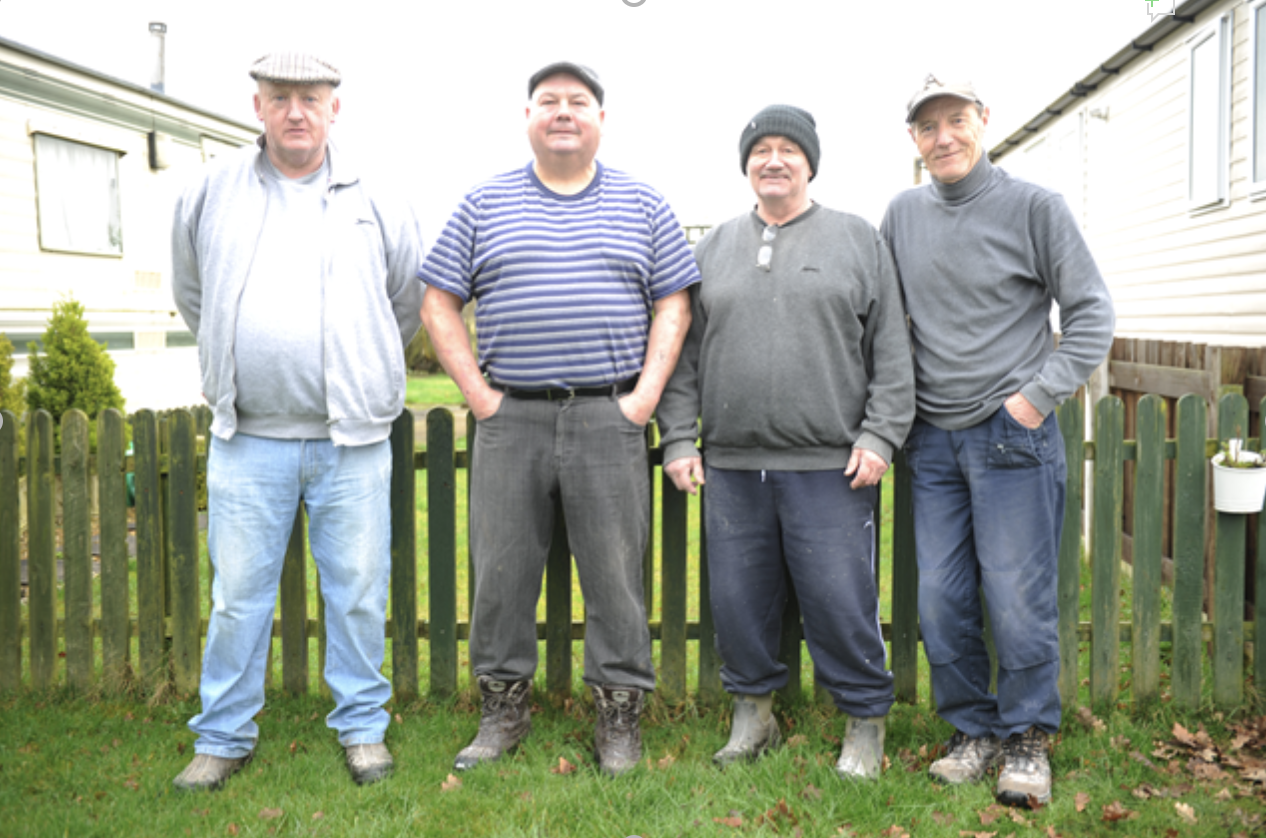
of the Curtis, Wall and Lunt partnership from Manchester.
